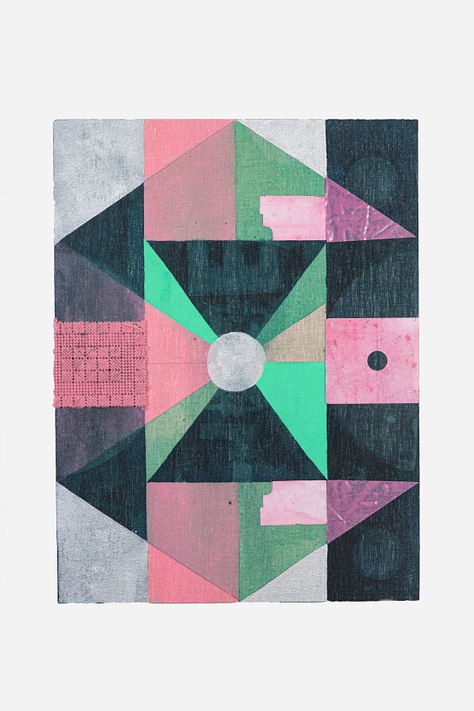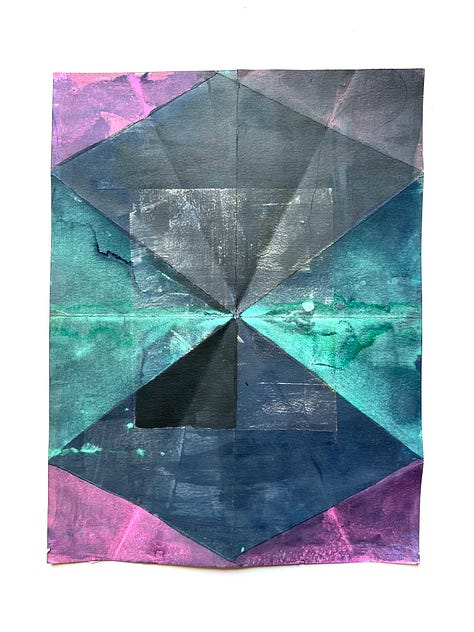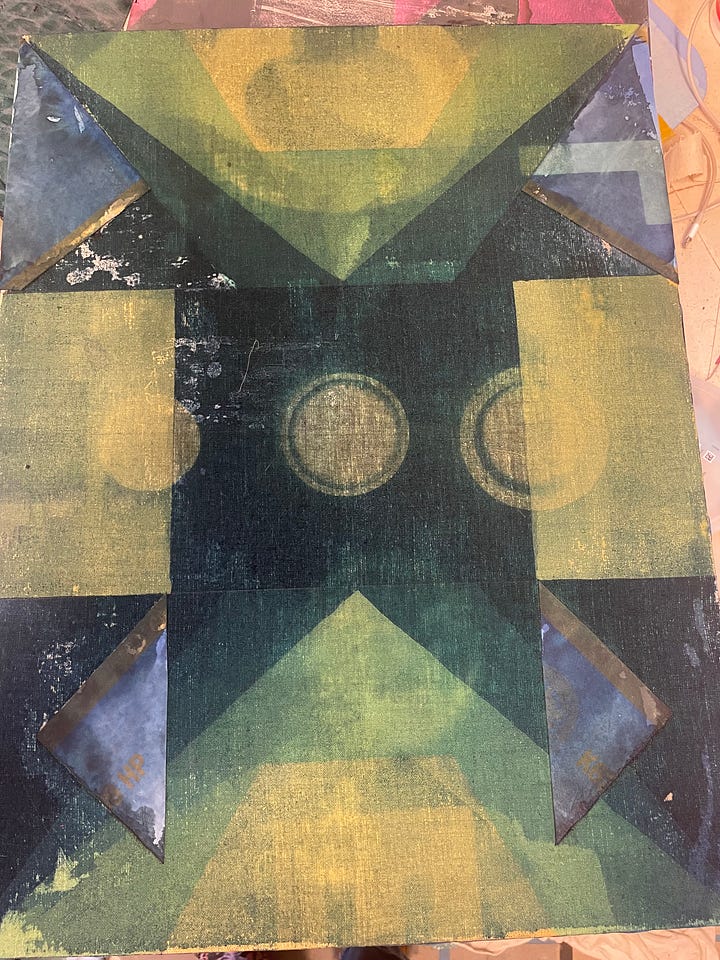“Perhaps home is not a place, but an irrevocable condition.” -James Baldwin





I have some new work in Colorado at Nick Ryan Gallery. The works are radial in composition, a new and surprising evolution in my practice. I made some folded constructions in the spring when at a residency. I was folding paper in the shape of a pyramid, drumming up some three dimensional work that I could flatten and economically ship back from upstate New York. In folding paper pyramids, I made centered compositions, like targets or paper fortune tellers, on the middle of the paper. The circular format departed from the logic of the grid, a conceptual framework that I have depended on for years (and still do). The resulting patterns recall quilt tops, my wheelhouse after all, that of deconstructing cardboard boxes (and maybe everything else).
Whatever the intuitive impulse or archival knowledge, I went with it. Maybe making the little constructions is a metaphysical muscle memory from my matriarchs of folding butter into to flour. Maybe the the way pools of water form ripples or how the sun radiates out, galaxies begin as a burst, or the way my wrist twists a paint brush. Maybe the central spoke recalls that of a wheel, or the emotional and psychic center of families, the condition of motherhood.
Or maybe these were a nod to the ways towns are formed, often growing from a central point on a river’s bend for trading or emanating out from the town hall square. My hometown in Arkansas boasts 2,302, almost doubling since I lived there. Timber was the industry back then, but now the river hosts Texans on holiday. People canoe and kayak down the Caddo that my Mom used to traverse as a 9 year old, on horseback, kicking up arrowheads (see the triangle theme?) along the way.
Navigating the space between home and ambition, or home and identity was what made Hilton Al’s Finding a Family of Boys so compelling (June 30th, New Yorker). Als writes of his “act of becoming” through traversing New York City back and forth from his family’s home in Brooklyn to school on Manhattan. I would read anything Als writes (and do, in the New Yorker, his Instagram, and White Girls, even his critical adjustment to Hannah Gadsby).
For those of you who did not grow up in or around New York, but have been made aware of its geography (through everything—culture, career ecosystems, movies, history, personal ambition, having actually lived there, or the thousands of other ways it makes it into common knowledge), Brooklyn is (at the longest) 11 miles away from the island of Manhattan. For those of you who did not grow up in or around Arkansas, but have been made aware of its geography (never, maybe through culture) my hometown is 400 miles from where I live in Tennessee. If you need a comparison, Portland Maine is 310 miles to Manhattan. When I lived in Boston, the trek from Maine to New York was like taking covered wagons across the prarie (I know, traffic). This country is vast.
For thirty years the same expanse of highway has hosted my drive to and from where ever I am rooted. Though covering more mileage, I understood a bit of Al’s whiplash in finding himself near and far from home, even if just subway ride. For me, the distance is a 7 hour car ride that takes me across the Tennessee and Mississippi Rivers, then over the Arkansas River and into the foothills of the Ozark Mountains. I have often considered how madly convenient (for me) to have family in New York, where being home could also mean a day trip to see a show at MoMA, studio visits or time with curators.
The drive is pretty much a straight shot West on 140, but still hard to make happen. There’s always work, kids, weather, my family’s own lives, and how long can we stay without pissing everyone off (three days, in election years)? I will get to make this trek more this Fall when I am an Artist in Residence at the University of Arkansas. I have some projects do make that only a clay program could host. Plus, the CD Wright archive is at the library there. I’ll get the touchstones of familiar trees, seeing the Memphis Pyramid and following the flat Delta long enough to see the tree line begin to bubble and emerge as mounds, then hills. It will, as usual, be a lot of manage, if done with health. You might see me dipping into the riverbanks, collecting dirt and arrowheads. Because my family lives in a different state.
Your Playlist:
Feel free to check out the podcast, as a couple of new episodes are out (David Anderson, Karen Dana Cohen!). Plus up next week, Barbara Campbell Thomas.






You write like a river: always telling of its source and carrying us somewhere big. Thank you.
And congrats on the residency - how exciting!